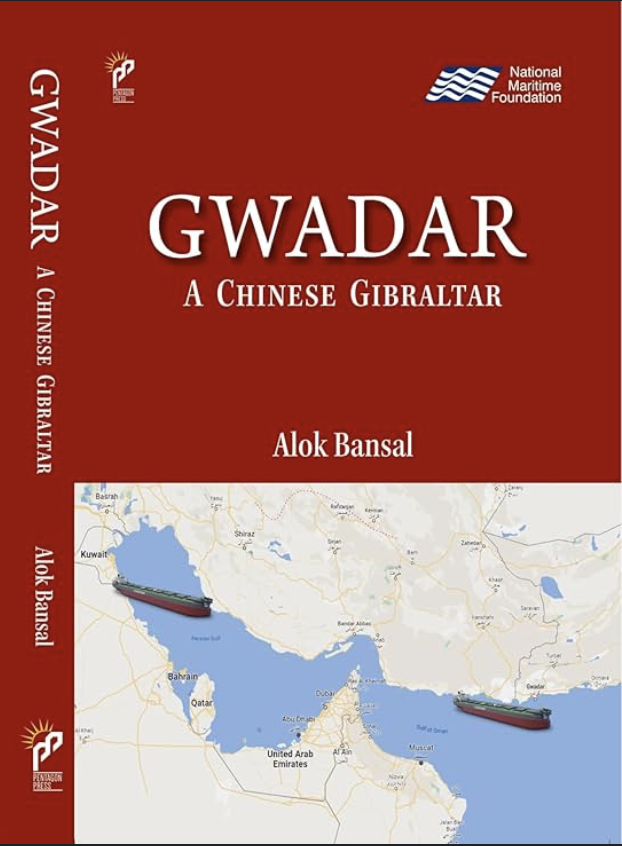“GWADAR: A CHINESE GIBRALTER”
Alok Bansal. New Delhi. Pentagon Press LLP, 2023. 224 pages, ISBN 978-81-951894-8-9.
Rs 995 (Hardcover)
Reviewed by:
Manjiri Abhay Phansalkar
In the current scenario of 21st century geopolitics and geostrategy, where countries and personalities are trying to establish their foothold as a global leader, China has delicately partnered with Pakistan to attain its goals of global leadership, economic hegemony as well as establish its geostrategic supremacy by means of mobilizing and exercising the deep-sea port of Gwadar on Pakistan’s Makran coast. The text by a retired Indian Naval Captain Alok Bansal, Gwadar: A Chinese Gibraltar highlights the strategic, economic and political attributes of Chinese operation of the Gwadar port while also representing the security concerns of the bordering nations and addresses the implications and influences of the operation of the upcoming deep-water port. The book, in totality discusses the importance of the Gwadar port especially with reference to the geopolitical entities in the neighborhood.
“An established South Asian expert on Pakistan and a well-known defense analyst, Captain Bansal possesses impressive academic and experiential knowledge of multiple facets of South Asian geopolitics”. His book, Gwadar: A Chinese Gibraltar introduces and discovers various facets such as geopolitical significance, geostrategic implications, economic prowess, security matters and influences on neighboring entities in a series of six compact segments. In the initial phase, the book attempts to draft out a brief context of the region of Gwadar as well as the surrounding region in reference to the erstwhile occupants, the dynamic history, demographic evolution as well as geographic features of the arena.
The author continues to bring out the significance of the Gwadar deep-sea port. This aspect is practiced in relevance with the firstly the geographical location (and the possibility of the port being exercised as an alternative to the previously existing ports at Omara and Karachi), secondly the advancements and innovations being implemented during the development of the deep-sea port (inviting investments and partnerships from key players in the global arena) and thirdly, presenting the short comings and limitations of the operation of the port post the idealization of the state-of-the-art facilities being established at the location.
Further, the book delves into the security implications for Pakistan, in both the dimensions of Internal and External Spheres. On the External Sphere of security, the main highlights are presented in the form of Maritime security-whereby Pakistan envisages a respite from possible naval blockades and trade hinderances faced by the Indian Navy. In the context of Reducing Economic Vulnerability whereupon the operation of Gwadar port in addition to the ports at Omara and Karachi provides not only an added factor of security, but also guarantees flexibility and extravagance in matters of international trade, commerce and an option of transshipment leadership Finally, merging Pakistan’s security strategies with that of China’s so as to establish safety, stability, as well as superiority in the region of tumultuous events. On the Internal Sphere of security, the author introduces the two main aspects of development of Gwadar and the impact on the region of Balochistan as well as the rection of the Balochi locals to the developments taking place on their land. It is noticeable herein, that the Balochis are particularly apprehensive of the developments on the Gwadar port, as it comes as an action to jeopardies their land so that the owners reap negligible benefits of the port.
China, a decisive player in the upgradation of Balochistan via the development of the Gwadar deep-sea port is shown to have heightened importance in the book. China’s efforts to assist Pakistan in this developmental project is viewed to be firstly, an attempt to enhace its geostrategic as well as economic standing on the global sphere and secondly, allow Pakistan to establish itself as a major stakeholder in global trade while also act as a lynchpin in the commerce of the land-locked countries within the Asian continent. The author addresses the Gwadar port as a major stakeholder in China’s CPEC, i.e. China-Pakistan Economic Corridor and is considered to be a leading project under China’s BRI i.e. Belt and Road Initiative.
Venturing into the latter section of the book, the author attempts to bring out the primary impacts on Regional Security that majorly concern the bordering region of Pakistan, as well as the influences on the extra-regional powers. With regards to Afghanistan and Central Asian Regions (once a part of the Soviet Union), it is discovered that the Gwadar port emerges as the soul of their trade and commerce with regions outside of Asia. However, the issue of resistance by the local Baloch population remains a matter of concern for the development of the deep-sea port. In context of Iran, the Gwadar port is a clear competitor to the Chabahar port being developed by the Iranian government, in collaboration with the Indian government. Referring to the United States, the book brings out the intricacies of the global economic competition between China and the US, because of which China’s rise as a global hegemon is becoming inevitable. Also citing the intricate relationship with Russia, the Gwadar port emerges as a combined effort to exercise relations on economic forums.
In the last section of the book, the author deals with the implications of the deep-sea port on India and states prime issues such as naval surveillance not only by the Pakistani Navy but the Chinese Navy as well, coupled with an attempt to jeopardies the maritime trade of the Indian subcontinent by mobilizing Gwadar as the hotspot for Asian commerce. Lastly, Chinese efforts on the Gwadar deep-sea port is visible intent to promulgate the concept of String of Pearls which aims to detrimentally harm India’s geostrategic posturing.
In the concluding segment of the text, the author presents certain engaging theories and fruitful recommendations for India to effectively negate the detrimental influence of the Gwadar port on Indian trade. One striking feature is the suggestion for India to engage with Baloch nationals and promote Chabahar port over Gwadar as a preferred gateway to Central Asia.
While the book is a source of unending facts and important conclusions, the author distinctively provides for a larger scope for greater research into various topics. Further, he also enlists a quantum of literature in the form of endnotes and bibliography that are valuable to readers.






